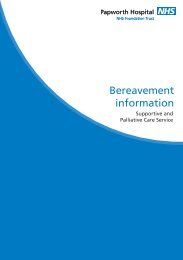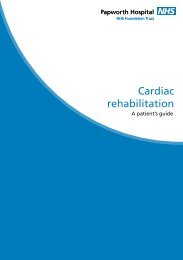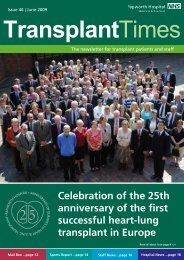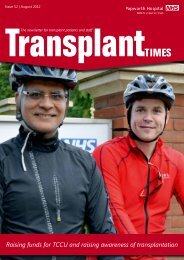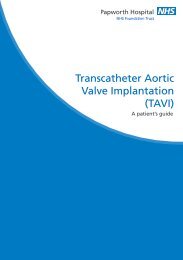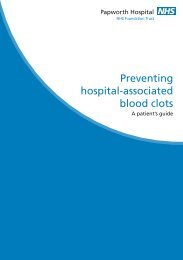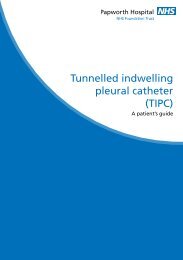CBC Design and Access Statement - Papworth Hospital
CBC Design and Access Statement - Papworth Hospital
CBC Design and Access Statement - Papworth Hospital
- No tags were found...
You also want an ePaper? Increase the reach of your titles
YUMPU automatically turns print PDFs into web optimized ePapers that Google loves.
The Expansion of Cambridge Biomedical Campus<strong>Design</strong> <strong>and</strong> <strong>Access</strong> <strong>Statement</strong>Appendix 6 – Public Art <strong>Statement</strong>Public Art Strategy for Cambridge Biomedical CampusThe Applicants propose to extend Cambridge Biomedical Campus (<strong>CBC</strong>) to provide a high quality newdevelopment for clinical use <strong>and</strong> biomedical <strong>and</strong> biotech research. The Applicants strongly believe thatthe environment they create should not only be high quality, but an imaginative <strong>and</strong> inspiring place to be.Public art adds to the quality of new public places. The recent CABE Space ‘Manifesto for Better PublicSpaces‘ notes that the public also feel strongly that their local open spaces should be attractive <strong>and</strong>engaging. Public art is stimulating debate at every level <strong>and</strong> the Applicants welcome the resultinggrowing range of ideas outlined in publications from planning authorities, bodies such as CABE <strong>and</strong>independent arts experts. For these proposals the Applicant has referred to the Cambridge City Council(CCC) document – Provision of Public Art as Part of New Development Schemes, <strong>and</strong> the CambridgeSouthern Fringe Area Development Framework (ADF).Such publications taken together raise many interesting points but views <strong>and</strong> opinions differ. In thecurrent context of increased debate the Applicants would like to take the opportunity to contribute. Asdevelopers they have a combined <strong>and</strong> extensive experience in building new sustainable developments<strong>and</strong> a long st<strong>and</strong>ing commitment to creating excellent public spaces. They would like to put forward theirstrategy for delivering good public art. They value this opportunity to demonstrate their strongcommitment to high quality public art <strong>and</strong> equally, their conviction that a purely financial approach topublic art would be the wrong one. The most valued public art is not always the most expensive, <strong>and</strong> theclinical <strong>and</strong> research uses will have different requirements, including for the provision of public art.The Public Art Strategy sets out the approach to creating a Public Art Framework followed by somediscussion of factors which the Applicants consider are key to successful delivery of public art. Thefinancial element of public art is a contentious point <strong>and</strong> they would like to address this issue. Anarbitrary approach of a fixed sum is not appropriate; hence the old adage ‘Art is Priceless.’ Asresponsible developers with a realm of experience in this area, they can offer local authorities peace ofmind that outst<strong>and</strong>ing public spaces will be delivered at the appropriate level of expenditure; the endproduct being a meaningful addition to the development, <strong>and</strong> of great personal value to employees <strong>and</strong>visitors.The main developers, Countryside Properties plc, Liberty Property Trust <strong>and</strong> Cambridge University<strong>Hospital</strong>s NHS Foundation Trust, wish to illustrate this further by outlining their historic approach to theprovision of public art <strong>and</strong> generally to the environments surrounding built development.Countryside Properties plcCountryside Properties are well known for their historical <strong>and</strong> pioneering approach to public art.Occupants of Countryside developments have enjoyed public art <strong>and</strong> attractive public spaces fordecades, whilst the majority of developers <strong>and</strong> local authorities have only become aware of theseconcepts <strong>and</strong> their benefits in recent years.As a market leader in regeneration <strong>and</strong> the creation of sustainable communities, Countryside recognisesthe importance of delivering a sense of community at the core of every development. Alan Cherry,Chairman, states ‘Our vision aims to bring the highest quality of life to everyone by putting in place all thesocial, environmental <strong>and</strong> economic elements that help to make integrated, vibrant <strong>and</strong> attractive placesin which to live.’The company is widely commended for its work, with an impressive collection of awards to illustrate theirtotal commitment to creating an individual sense of place at each <strong>and</strong> every development.This illustration is the square at Didsbury Point. This particular example shows how public art can beintegrated into a l<strong>and</strong>scape frame work <strong>and</strong> can stimulate not only the visual senses, but the auditorysenses – in this example with the sound of water.44







